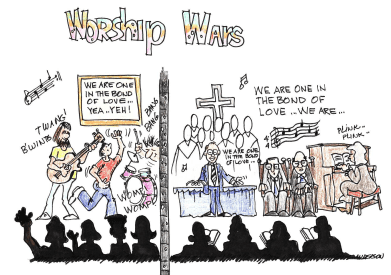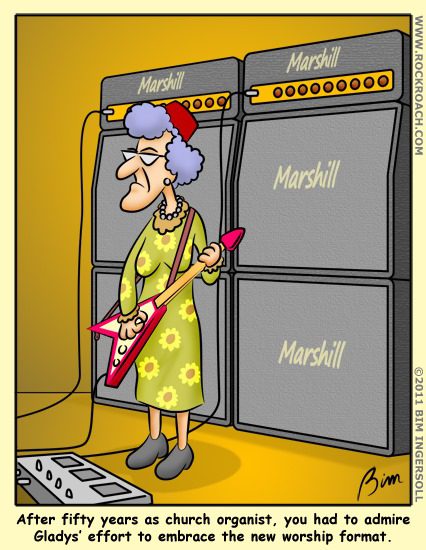
Any cursory reading of the Bible reveals that the “church” — the elect, god’s chosen ones, the saved — are commanded to live at peace among themselves. How pleasant it is for the brethren to dwell in unity, (Psalm 133:1) the Bible says. Filled with the Holy Spirit, Christians should daily demonstrate the fruit of the Spirit in their lives: love, joy, peace, forbearance, kindness, goodness, faithfulness, gentleness, and self-control. The Apostle Paul told Trinity Baptist Church in Corinth: I appeal to you, brothers and sisters, in the name of our Lord Jesus Christ, that all of you agree with one another in what you say and that there be no divisions among you, but that you be perfectly united in mind and thought. (1 Corinthians 1:10) Speaking of the early church, the writer of the book of Acts said in chapter 4: All the believers were one in heart and mind. No one claimed that any of their possessions was their own, but they shared everything they had. Jesus said in John 13:35: By this everyone will know that you are my disciples, if you love one another. 1 Peter 3:8 says, Finally, all of you, be like-minded, be sympathetic, love one another, be compassionate and humble. And finally, Paul tells First Baptist Church of Ephesus:
Make every effort to keep the unity of the Spirit through the bond of peace. There is one body and one Spirit, just as you were called to one hope when you were called; one Lord, one faith, one baptism; one God and Father of all, who is over all and through all and in all. (Ephesians 4:3-6)
Compare what the inspired, inerrant, and infallible Word of God commands with what we actually see in most Evangelical churches. Several decades ago, Evangelical churches began moving from traditional worship services with primarily hymn singing to contemporary worship services with primarily contemporary Christian and praise and worship singing. The former had a song leader leading music from a hymnbook, the latter a worship team using songs typically projected on a screen with an overhead projector. The former used a piano and organ, the latter used guitars, drums, and keyboards. (These are general observations.)
I started out in the 1970s preaching in churches that had traditional worship services. Over time, we added a few choruses and praise and worship songs, but, for the most part, our worship services were not much different from those from the 1950s. In 1995, I started Our Father’s House in West Unity, Ohio in 1997. Our Father’s House was a nondenominational church, though our worship style was traditional. This changed after our three oldest sons took guitar and bass lessons and needed an outlet for their music. I decided to move from a traditional worship style to what is called a blended worship style. Every Sunday, we sang both hymns and praise and worship music. As we added people and instruments to our band, the music focused more on newer styles of worship. However, hymns were always a part of our worship, just less so.
The change in music ruffled the feathers of three church families, who demanded we stop using contemporary music, or what they called charismatic music. I refused, reminding them that we sang hymns each week, and that the newer music appealed to younger adults and teenagers. These families left in a huff, the only people to leave the church in the seven years I was blessed to be their pastor.

In 2004, we moved from rural northwest Ohio to Yuma, Arizona — a move that we hoped would improve my health. One church we attended was a Church of the Nazarene congregation which held two services on Sundays: an early service that used traditional music and a late service that used a blended music approach. We attended the late service. We preferred praise and worship music, and those attending the service were younger, people with families. The early services were attended primarily by people in their fifties and sixties; people who were thrilled church was over by ten so they could then eat breakfast at Denny’s. The early service was boring, geared toward old people. Each service time had a different preacher. The early service preacher was a retired pastor; the late service preacher was a pastor in his late 30s. We preferred the younger guy.
The church didn’t need to hold two services. They did so to keep everyone happy. In an effort to keep everyone satisfied and tithing, church leaders split the congregation. This, however, didn’t stop the conflict between the two factions. The church later returned to one service on Sundays at 10:30 am. Not far from our home is a Church of God that holds two services. The early service (traditional 8:30 am)) is primarily attended by old people — farmers and first-shift factory workers. The late service (contemporary 11:00 am) is attended by younger adults — frazzled younger couples with children and others who love sleeping in on Sundays.
As a pastor, I was opposed to split services. I also, later in my ministerial career, opposed children’s church programs. I believed worship was meant to be done together: all ages in one room, families sitting together, worshipping the Lord. We visited numerous churches that divided people up into various groups, choosing to reserve worship services for adults alone. Preschoolers, children, and teenagers attended services geared towards their “needs” — as if worship is all about personal wants and needs. In 2005-06, we attended a Missionary Church in Pettisville, Ohio. The church had traditional (8:30 am) and contemporary (10:30 am) services, with age-focused programs during the contemporary services. We are not early morning people — never have been — so we attended the late service. One Sunday, the church’s youth director came up to our children and tried to get them to attend the youth service. I quickly cut him off, telling the youth pastor that we believed in family worship. We worshiped together as a family. By then, I had a distrust of youth directors, knowing that the levels of sexual misconduct by youth pastors were high. I also knew that youth pastors typically dumbed down their services, and focused on keeping teens entertained for an hour or so. I didn’t want this for my children.
My opinion remains unchanged on this issue. The worship wars have caused incalculable harm and division. People who are members of the same church rarely worship together. Some churches, out of necessity, hold multiple services, but most churches hold multiple services to placate people who either want a certain style of music or want to attend church at a certain time. Instead of focusing on unity, churches, fearing disgruntled members leaving and taking their money with them, cater to the whims of people who can’t or won’t sing certain styles of music.
Do you have experiences with the Evangelical worship wars? Did your church have multiple services? Please share your thoughts in the comment section.
Bruce Gerencser, 66, lives in rural Northwest Ohio with his wife of 45 years. He and his wife have six grown children and thirteen grandchildren. Bruce pastored Evangelical churches for twenty-five years in Ohio, Texas, and Michigan. Bruce left the ministry in 2005, and in 2008 he left Christianity. Bruce is now a humanist and an atheist.
Connect with me on social media:
Your comments are welcome and appreciated. All first-time comments are moderated. Please read the commenting rules before commenting.
You can email Bruce via the Contact Form.
